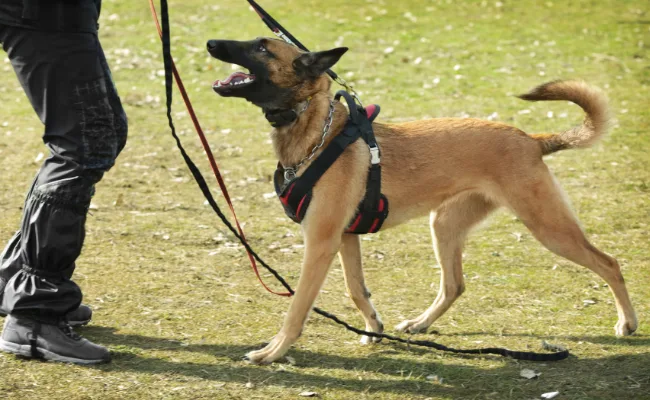
Walking your dog with a harness is often the safest and most comfortable choice. Unlike collars, harnesses distribute pressure evenly across your dog’s body, protect their neck, and help reduce pulling. However, not all dogs take to wearing a harness right away.
Some dogs may be sensitive to touch, dislike gear going over their head, or feel startled by the sound of buckles snapping. These challenges can be frustrating for pet owners, but with the right approach, you can teach your dog to feel comfortable and even enjoy wearing a harness. This guide will walk you through effective training techniques and offer solutions to common harness-related issues.
Key Takeaways
- Patiently introduce the harness to your dog, ensuring comfort and familiarity.
- Utilize positive reinforcement techniques to encourage harness acceptance.
- Consistency and gradual adjustment are key to successful training.
- Recognize and respect your dog’s comfort zone during training sessions.
Choose the Right Harness
Before you begin training, selecting the appropriate harness is crucial. Consider your dog’s size, breed, and specific behavior needs. A well-fitted harness should be snug yet comfortable, allowing two fingers to fit between the harness and your dog’s body. Look for durable materials and adjustable straps to ensure a tailored fit. A suitable dog harness with handle is the foundation of practical training.
How To Introduce Your Dog to Their Harness
The best way to harness train your dog is to take a slow and relaxed approach, as recommended by Pat Miller. Every dog has a different comfort level with wearing a harness—some adapt quickly, while others need more time to adjust. The key to success is patience and allowing your dog to progress at their own pace without pressure or force.
To help your dog see the harness as something positive rather than a source of fear, start by building positive associations before attempting to put it on. Begin by placing the harness on the ground and letting your dog sniff and explore it freely. To encourage curiosity, sprinkle treats on or around the harness, making it a rewarding experience.
Once your dog seems comfortable with the harness on the floor, pick it up and reward them with a treat each time you do so. If your dog isn’t treat-motivated, you can use other rewards like praise, affection, or their favorite toy to create positive associations. Over time, your dog should become excited when they see the harness because they associate it with something enjoyable.
This process may take days or even weeks for some dogs. It’s important to watch for signs of distress that indicate you’re moving too quickly. Avoidance behaviors like moving away from the harness, freezing, or shutting down are clear signals that your dog is nervous. Other signs include whining, barking, growling, cowering, tail tucking, lip licking, or flattened ears.
If you notice any of these behaviors, take a step back and continue working on positive reinforcement at a slower pace. Rushing the process can make your dog more fearful of the harness, so patience and consistency are essential for successful training. With time and care, your dog will learn to feel comfortable and confident wearing their harness.
Over-the-Head vs. Step-In Harness
Harnesses come in two primary styles: step-in harnesses and over-the-head harnesses. While the initial introduction to both types follows the same approach, the steps for putting them on your dog will differ slightly once your dog is ready to wear the harness.
How to Train Your Dog to Wear a Step-In Harness
A step-in harness requires your dog to place their front paws into the straps before fastening it around their body. Follow these steps to make the process smooth and stress-free:
- Introduce the Harness: Place the harness on the ground and let your dog sniff and explore it freely.
- Encourage Paw Placement: Use treats to lure your dog to step into the harness openings with their front paws.
- Gradual Adjustment: Slowly lift the harness an inch or two at a time, rewarding your dog with treats for staying calm.
- Fasten the Straps: Once the harness is on, have a partner offer treats while you buckle it. If you’re alone, use a Lick Mat smeared with dog-safe peanut butter to keep your pup occupied.
How to Train Your Dog to Wear an Over-the-Head Harness
Some dogs may feel nervous about gear going over their head, but you can ease their anxiety with these steps:
- Introduce the Harness: Hold the harness in front of your dog while offering a treat through the head opening to encourage them to put their head through voluntarily.
- Reinforce Calm Behavior: Reward your dog with treats every time they willingly place their head through the harness.
- Secure the Buckles: Once the harness is in place, have someone feed treats while you fasten it. If training solo, use a Lick Mat to keep your dog focused and relaxed.
Pro Tip: Always let your dog choose to put their head into the harness rather than forcing it on them. This builds trust and ensures a positive experience during training.
By following these steps patiently and using positive reinforcement, you can help your dog feel comfortable and confident wearing any harness!
Resolving Common Harness Training Issues
Harness training can be tricky for some dogs, but with patience and the right approach, you can overcome common challenges. Here are expert tips to address specific issues:
What Should I Do If My Dog Runs Away When They See the Harness?
If your dog runs away, it’s a clear sign they’re afraid of the harness. Start from scratch and work slowly to change their association with it. Pair the harness with high-value treats and only progress when your dog appears comfortable.
In some cases, a harness may not be suitable for your dog. If they continue to find it aversive, consider alternative tools like a martingale collar or Gentle Leader. You might also explore different harness styles to find one that works better for your pup’s needs.
What If My Dog Is Frightened by the Sound of Buckles Snapping?
Dogs sensitive to noise can benefit from gradual counterconditioning. Start by snapping the buckles at a distance where your dog notices the sound but doesn’t react negatively. Immediately reward them with a treat after each snap.
Over time, move closer while repeating this process. The goal is for your dog to associate the snapping sound with positive reinforcement. Be patient—this may take time, but slow progress ensures lasting results.
What Should I Do If My Dog Gets the Zoomies Once Their Harness Is On?
Zoomies after putting on a harness are common and usually stem from excitement about an upcoming walk or adventure. If possible, let your dog burn off their energy before proceeding with your plans.
To reduce overexcitement, try putting on the harness several times throughout the day without heading out immediately. Leave it on for a few minutes while you go about your routine, then remove it. This helps your dog understand that wearing a harness doesn’t always mean an outing is coming.
How Can I Choose the Right Harness for My Dog?
Selecting the right harness is essential for successful training and comfort:
- Walking Style: Front-clip harnesses are ideal for pullers, while back-clip models work well for dogs who walk calmly. Escape-proof designs are great for dogs prone to slipping out of gear.
- Size and Body Type: Small dogs benefit from step-in or vest-style harnesses that avoid pressure on their delicate tracheas. Large breeds often need front-clip or over-the-head models for better control and comfort during walks.
An ill-fitting harness can cause discomfort or limit mobility, so always ensure proper sizing and adjust straps as needed to keep your dog secure yet comfortable.
With these solutions and tips, you can address common harness training issues effectively while ensuring your dog feels safe and confident wearing their gear!
FAQS.
How do I introduce a harness to my dog for the first time?
To introduce a harness, let your dog sniff and explore it first. Place it on the ground and reward them with treats for calm behavior. Gradually drape the harness over their back without fastening it, giving treats each time. Take it slow to build positive associations.
What’s the best way to train a dog that’s scared of wearing a harness?
If your dog is scared of wearing a harness, start by pairing it with treats to create positive associations. Let them sniff and explore it without pressure. Gradually introduce the harness by placing it on their back without fastening, rewarding calm behavior. Take it slow and be patient.
How can I stop my dog from pulling while wearing a harness?
To stop your dog from pulling while wearing a harness, use a front-clip harness for better control. Teach the “heel” command and reward them for walking calmly beside you. Stop walking when they pull and resume only when they relax. Consistent training and patience are key.
What type of harness is best for training a puppy?
The best harness for training a puppy is an adjustable, lightweight design that grows with them, like the Halti Anatomy Puppy Harness. It offers freedom of movement, four adjustment points for a perfect fit, and soft padding for comfort. A step-in or back-clip harness is ideal for gentle control.
How do I get my dog comfortable with the sound of harness buckles?
To help your dog get comfortable with the sound of harness buckles, start by snapping the buckles at a distance where they notice but don’t react negatively. Reward them with a treat after each snap. Gradually move closer and repeat the process until they associate the sound with positive experiences.



